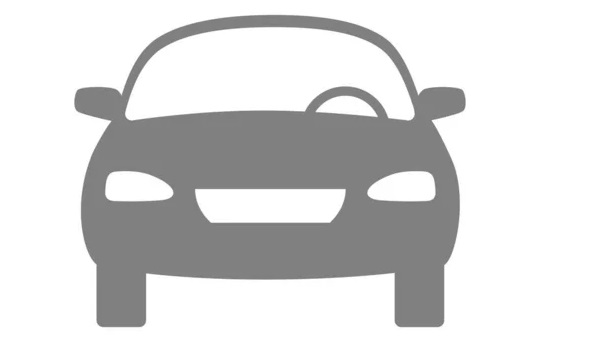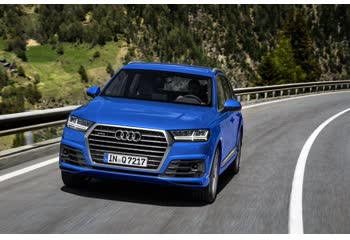Everything you need to know about specifications and performance - Audi Q7 2024 - 60 TFSI e V6 (490 Hp) Plug-in Hybrid quattro tiptronic

Overview:
What is the engine capacity of a Audi Q7 2024?
The engine capacity of the Audi Q7 2024 is 2995.
Audi Q7 2024 How many horsepower?
The engine power of the Audi Q7 2024 is 340 Hp @ 5200-6400 rpm..
How powerful is the electrical system in the Audi Q7 2024?
The power of the electrical system in the Audi Q7 2024 is 490 Hp hp.
General:
Brand: Audi
Model: Q7
Generation: Q7 (Typ 4M, facelift 2024)
Modification (Engine): 60 TFSI e V6 (490 Hp) Plug-in Hybrid Quattro Tiptronic
Start of production: April, 2024
End of production:
Powertrain Architecture:Plug-In Hybrid Electric Vehicles (PHEVs)
Body type:Sports Utility Vehicle (SUV)
Seats: 5
Doors: 5
Engine:
Engine systems: Start & Stop System
Power: 340 hp @ 5200-6400 rpm.
Power per litre: 113.5 hp/l
Torque: 500 nm @ 1370-4500 rpm.
Engine displacement: 2995
Number of cylinders: 6
Engine configuration: V-engine
Number of valves per cylinder: 4
Fuel injection system: Direct injection
Engine aspiration: Turbocharger, Intercooler
Valvetrain: DOHC
Engine oil capacity: 7.2 l
Coolant: 17.4 l
Engine layout: Front, Longitudinal
Cylinder Bore: 84.5 mm
Piston Stroke: 89 mm
Compression ratio: 11.2:1
Performance:
Fuel Type: Petrol / electricity
Combined fuel consumption (WLTP): 1.3-1.4 l/100 km
Emission standard: Euro 6e
Acceleration 0 - 100 km/h: 5 sec
Acceleration 0 - 62 mph: 5 sec
Maximum speed: 240 km/h, Electronically limited
Weight-to-power ratio: 4.9 kg/Hp, 205.5 Hp/tonne
Weight-to-torque ratio: 3.4 kg/Nm, 293.5 Nm/tonne
Max speed (electric): 140 km/h
Acceleration 0 - 60 mph: 4.8 sec
Electric system:
Net (usable) battery capacity: 22 kWh
Gross battery capacity: 25.9 kWh
Battery technology: Lithium-ion (Li-Ion)
Battery location: Under the trunk
System power: 490 hp
System torque: 700 nm
All-electric range: 80-84 km
Electric motor power: 177 hp
Electric motor Torque: 460 nm
Average Energy consumption: 28-29.1 kWh/100 km
Electric motor location: Between the combustion Engine and the transmission
Average Energy consumption (WLTP): 28-29.1 kWh/100 km
Electric motor type: Synchronous
All-electric range (WLTP): 80-84 km
Battery voltage: 400 V
Recuperation output: 80 kW
Space:
Kerb Weight (kg): 2385
Max. weight (kg): 3100
Max. roof load: 100 kg
Max load (kg): 715
Trunk (boot) space - maximum: 1863 l
Trunk (boot) space - minimum: 563 l
Permitted trailer load with brakes (12%): 2800 kg
Fuel tank capacity: 75 l
Permitted trailer load without brakes: 750 kg
Permitted towbar download: 115 kg
Permitted trailer load with brakes (8%): 2800 kg
dimensions:
Length: 5072 mm
Width: 1970 mm
Height: 1690-1748 mm
wheelbase: 2995 mm
Width including mirrors: 2212 mm
Front track: 1673 mm
Rear (Back) track: 1685 mm
Front overhang: 982 mm
Rear overhang: 1095 mm
Minimum turning circle (turning diameter): 12.5 m
Approach angle: 23.1°
Departure angle: 21.7°
Powertrain, Suspension and Brakes:
Drivetrain Architecture: The Internal combustion Engine (ICE) and the electric motor permanently drive the four wheels of the car with the ability to work in full electric or mixed mode.
Drive wheel: All wheel drive (4x4)
Number of gears and type of gearbox: 8 gears, automatic transmission Tiptronic
Front brakes: Ventilated discs, 400 mm
Rear brakes: Ventilated discs, 350 mm
Assisting systems: ABS (Anti-lock braking system)
Steering type: Steering rack and pinion
Power steering: Electric Steering
Tires size: 255/55 R19; 285/45 R20; 285/40 R21; 285/35 R22
Wheel rims size: 8.5J x 19; 9J x 20; 9.5J x 21; 10J x 22
Front suspension: Independent multi-link suspension, Transverse stabilizer, Air suspension
Rear suspension: Independent multi-link suspension, Air suspension, Transverse stabilizer
See also

Other generation.
Its production began in 2016 until 2018
Write a comment